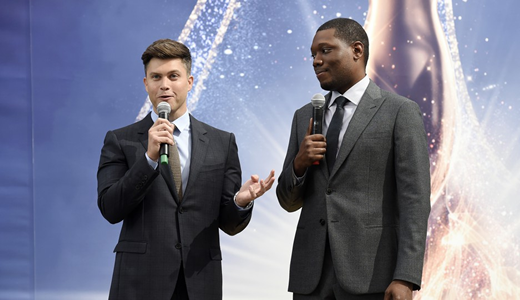Did you watch the Emmys? If so you’re one of a select few. Television’s annual awards gala posted a 7.4 rating—which might not mean much to you, but it’s apparently a 10% drop from the previous year and puts the viewership bar at an all-time low. Like, don’t-try-to-limbo-under-that-sucker low.
Some will naturally point to the hosts, Colin Jost and Michael Che from Saturday Night Live, who struck many as unfunny and apathetic. “It’s as though they absorbed and internalized the audience’s disappointment during every commercial break,” wrote EW.com’s Kristen Baldwin. Some will say the whole evening felt a little, well, boring.
But when you check out the evening’s winners, something else strikes me: A lot of the honorees—indeed, most of the nominees—weren’t exactly easy to watch.
On one level, I mean that quite literally. Only one of the evening’s winners, Saturday Night Live, which won for Outstanding Variety Sketch Series, actually airs on traditional broadcast television. Folks who don’t have cable or access to streaming services (which, admittedly, isn’t many of us these days) had no way of seeing whether these shows were good or not.
Some of the biggest awards hogs—Game of Thrones, Westworld, Barry, etc.—air on HBO, a premium cable network that only 10% of Americans have. Netflix, home to such Emmy darlings as Godless and The Crown, has around 52 million subscribers—a big number, but hardly ubiquitous. Even Emmy-winning shows that played on basic cable weren’t watched by many folks. FX’s The Assassination of Gianni Versace: American Crime Story was watched, at its highest, by 4 million viewers—a plink in the bucket, given the U.S. has a population of 325.7 million.
But even when regular ol’ discerning viewers could watch such shows, would they?
Television parental guideline ratings aren’t nearly as ubiquitous as the MPAA’s ratings for movies, but TV still has them. They begin at TV-Y, which is “appropriate for all children,” and go all the way up to TV-MA, television’s version of the R-rating.
Now, let’s look at some of the big winners.
Amazon’s The Marvelous Mrs. Maisel took home five Emmys, including for best comedy series and for best lead actress in a comedy (Rachel Brosnahan). It’s TV-MA.
Game of Thrones pocketed another two awards, including for best drama. Also TV-MA.
The Assassination of Gianni Versace: TV-MA. Godless: TV-MA. The Americans: TV-MA.
Do you know how many fictional show winners weren’t typically rated “for mature audiences only?” Zero. Not a single one.
To get to anything that doesn’t have a TV-MA rating, you have to look at the game-show/reality show/variety show category, and even then the pickings are slim. RuPaul’s Drag Race collected an Emmy for best reality show, and it’s rated TV-14. But many Christian families might be disinclined to spend an evening watching a competition amongst cross-dressers.
Every year, we make a deal over the disparity between the R-rated movies that typically are Oscar front-runners and the PG-13 movies that always draw the crowds. Time and again, stats and studies show that moviegoers aren’t clamoring for a lot of problematic content, and Hollywood sometimes proves that you can make excellent, award-winning movies without a lot of wince-worthy scenes.
Aesthetically, television has never been better. Creators are crafting worthy stories filled with moving performances and crisp, insightful writing.
And yet, the television landscape has never been so fragmented. The ratings, overall, have never been so low. Could it be that the world of TV could learn the same lesson? That you can craft Emmy-worthy programming without all the graphic content, and that more people would (gasp) watch if you did so?
I’m not holding my breath, but here’s to hoping.






Recent Comments